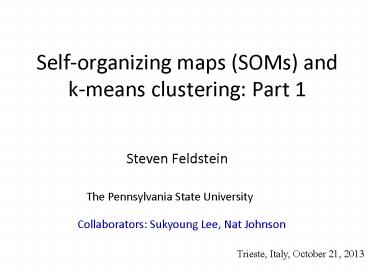Self-organizing maps (SOMs) and k-means clustering: Part 1 - PowerPoint PPT Presentation
1 / 20
Title:
Self-organizing maps (SOMs) and k-means clustering: Part 1
Description:
Title: PowerPoint Presentation Last modified by: Steven Feldstein Created Date: 1/1/1601 12:00:00 AM Document presentation format: On-screen Show (4:3) – PowerPoint PPT presentation
Number of Views:153
Avg rating:3.0/5.0
Title: Self-organizing maps (SOMs) and k-means clustering: Part 1
1
Self-organizing maps (SOMs) and k-means
clustering Part 1
Steven Feldstein
The Pennsylvania State University
Collaborators Sukyoung Lee, Nat Johnson
Trieste, Italy, October 21, 2013
2
Teleconnection Patterns
- Atmospheric teleconnections are spatial patterns
that link remote locations across the globe
(Wallace and Gutzler 1981 Barnston and Livezey
1987) - Teleconnection patterns span a broad range of
time scales, from just beyond the period of
synoptic-scale variability, to interannual and
interdecadal time scales.
3
Methods for DeterminingTeleconnection Patterns
- Empirical Orthogonal Functions (EOFs) (Kutzbach
1967) - Rotated EOFs (Barnston and Livezey 1987)
- One-point correlation maps (Wallace and Gutzler
1981) - Empirical Orthogonal Teleconnections (van den
Dool 2000) - Self Organizing Maps (SOMs) (Hewiston and Crane
2002) - k-means cluster analysis (Michelangeli et al.
1995)
4
Advantages and Disadvantages of various techniques
- Empirical Orthogonal Functions (EOFs) patterns
maximize variance, easy to use, but patterns
orthogonal in space and time, symmetry between
phases, i.e., may not be realistic, cant
identify continuum - Rotated EOFs patterns more realistic than EOFs,
but some arbitrariness, cant identify continuum - One-point correlation maps realistic patterns,
but patterns not objective organized, i.e.,
different pattern for each grid point - Self Organizing Maps (SOMs) realistic patterns,
allows for a continuum, i.e., many NAO-like
patterns, asymmetry between phases, but harder to
use - k-means cluster analysis Michelangeli et al. 1995
5
The dominant Northern Hemisphere teleconnection
patterns
North Atlantic Oscillation
Pacific/North American pattern
Climate Prediction Center
6
Aim of EOF, SOM analysis, and k-means clustering
- To reduce a large amount of data into a small
number of representative patterns that capture a
large fraction of the variability with spatial
patterns that resemble the observed data
7
Link between the PNA and Tropical Convection
Enhanced Convection
From Horel and Wallace (1981)
8
A SOM Example
P11958-1977 P2 1978-1997 P31998-2005
Northern Hemispheric Sea Level Pressure (SLP)
9
Another SOM Example (Higgins and Cassano 2009)
10
A third example
11
How SOM patterns are determined
- Transform 2D sea-level pressure (SLP) data onto
an N-dimension phase space, where N is the number
of gridpoints. Then, minimize the Euclidean
between the daily data and SOM patterns
where is the daily data (SLP) in the
N-dimensional phase, are the SOM
patterns, and i is the SOM pattern number.
12
How SOM patterns are determined
- E is the average quantization error,
- The (SOM patterns) are obtained by
minimizing E.
13
SOM Learning
Initial Lattice (set of nodes)
Nearby Nodes Adjusted (with neighbourhood kernel)
BMU
Data
Randomly-chosen vector
Convergence Nodes Match Data
14
SOM Learning
- 1. Initial lattice (set of nodes) specified (from
random data or from EOFs) - 2. Vector chosen at random and compared to
lattice. - 3. Winning node (Best Matching Unit BMU) based
on smallest Euclidean distance is selected. - 4. Nodes within a certain radius of BMU are
adjusted. Radius diminishes with time step. - 5. Repeat steps 2-4 until convergence.
15
How SOM spatial patterns are determined
- Transform SOM patterns from phase space back to
physical space (obtain SLP SOM patterns) - Each day is associated with a SOM pattern
- Calculate a frequency, f, for each SOM pattern,
i.e., - f ( ) number of days is chosen/total
number of days
16
SOMs are special!
- Amongst cluster techniques, SOM analysis is
unique in that it generates a 2D grid with
similar patterns nearby and dissimilar patterns
widely separated.
17
Some Background on SOMs
- SOM analysis is a type of Artificial Neural
Network which generates a 2-dimensional map
(usually). This results in a low-dimensional view
of the original high-dimension data, e.g.,
reducing thousands of daily maps into a small
number of maps. - SOMs were developed by Teuvo Kohonen of Finland.
18
Artificial Neural Networks
- Artificial Neural Networks are used in many
fields. - They are based upon the central nervous
system of animals. - Input Daily Fields
- Hidden Minimization of
- Euclidean Distance
- Output SOM patterns
19
A simple conceptual example of SOM analysis
Uniformly distributed data between 0 and 1 in
2-dimensions
20
A table tennis example (spin of ball)Spin occurs
primarily along 2 axes of rotation. Infinite
number of angular velocities along both axes
components.
Joo SaeHyuk
???
- Input - Three senses (sight, sound, touch)
feedback as in SOM learning - Hidden - Brain processes information from senses
to produce output - Output - SOM grid of various amounts of spin on
ball. - SOM grid different for every person































